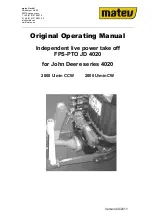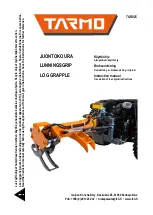
INTRODUCTION
ELECTRICAL SYSTEMS
• If it is necessary to use auxiliary batteries, you must connect the cables on both sides as follows: (+) to (+) and (-)
to (-). Avoid causing the terminals to short circuit. GAS RELEASED FROM BATTERIES IS HIGHLY FLAMMABLE.
During charging, leave the battery compartment open to improve ventilation. Avoid sparks and naked flames near
the battery. Do not smoke.
• Do not charge the batteries in enclosed spaces.
• Always disconnect the batteries before carrying out any type of servicing on the electrical system.
HYDRAULIC SYSTEM
• A little fluid coming out of a small bore could be almost invisible, but strong enough to penetrate the skin. For this
reason, NEVER USE YOUR HANDS TO CHECK FOR LEAKS. Instead, use a piece of cardboard or timber. If any
fluid penetrates your skin, seek medical assistance immediately. Failure to seek immediate medical assistance
could result in serious infections or dermatitis.
• Always read the system pressure using suitable gauges.
WHEELS AND TIRES
• Make sure that the tires are correctly inflated at the pressure specified by the manufacturer. Inspect the rims and
tires regularly for any damage.
• Remain next to the tire when filling it with air.
• Only check the pressure when the tractor has no load and the tires are cold, in order to prevent inaccurate readings
caused by overpressure.
• Never cut or weld a rim with a full tire fitted.
• When removing wheels, lock both the front wheels and the rear wheels of the tractor. Lift the tractor and install
stable and secure supports under the tractor, in accordance with the legislation in force.
• Deflate the tire before removing any objects that may be caught in the tire tread.
• Never inflate tires using flammable gases, as they could cause explosions and injure bystanders.
REMOVAL AND INSTALLATION
• Lift and handle all heavy components using hoist devices of appropriate capacity. You must suspend the parts using
suitable hooks and slings. Use the hoist eyes provided for this purpose. Be careful if there are any bystanders near
the hoisted load.
HEALTH AND SAFETY PRECAUTIONS
Many of the procedures involved in vehicle maintenance and repair services involve physical hazards and other health
risks. This section is an alphabetical list of some of these hazardous procedures and the materials and equipment
associated with them. It identifies the precautions necessary for avoiding these hazards.
The list is not comprehensive. You must take health and safety into account when carrying out all operations and
procedures and when handling materials.
ACIDS AND ALKALIS
See Battery acids, e.g. caustic soda, sulfuric acid.
Used in batteries and cleaning materials.
Irritate and corrode the skin, eyes, nose, and throat. Causes burns.
Avoid splashing into your eyes and nose, or onto your skin and clothing. Wear suitable sleeves and protective goggles.
Can destroy normal protective clothing. Do not inhale the fumes.
Soap and water must always be available in case of accidental splashing.
47402793 23/04/2014
12
















































